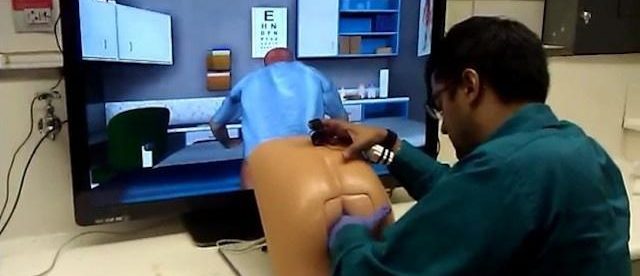Domo Arigato, Mr. Robutto

According to the American Cancer Society, approximately one in nine men will be diagnosed with prostate cancer during their lifetimes. The disease has a very high survival rate — approximately 98% of those diagnosed with the disease have a five-year relative survival rate. To get ahead of the disease, that ACS suggests annual prostate screenings for men as young as 40, depending on family history.
That test, though, can be uncomfortable for both the patient and the doctor alike — because it requires a rectal exam.
For the patients, the exam is better than the alternative of having undetected cancer, so most just grin and bear it. For the doctor, it’s part of the job. But what about medical students and aspiring doctors out there? Checking a patient’s prostate takes a certain bedside manner — one which requires the physician to be comfortable and well-versed in performing the exam. That takes practice — and how does one practice giving such an exam, exactly?
Meet Patrick, below. He’s a robotic butt.

In 2011, the National Science Foundation awarded a grant to a group of researchers across multiple academic institutions, hoping to identify a way to make the prostate exam less awkward. And the contraption above is the answer the came up with. Patrick — the reason for that name has gone unreported — is more than just a scale model of a backside. As one of its developers told The Mary Sue, the robo-butt connects to a screen with the rest of a “virtual human patient [who] can talk to the learner, expresses fears and concerns about the prostate exam, and presents a realistic patient encounter.” The idea is to not just teach what parts to check, but also to simulate how a typically-apprehensive patient will react when you tell him about the need for this test.
The simulation doesn’t end there, either. Patrick aims to provide feedback during the example , both from the patient’s point of view as well as from that of medical science. As KQED reported, “Patrick comes equipped with four sensors, and its highly-visual software can inform students whether they’re applying optimal pressure. He might inform the student if the pressure is too soft or if they have neglected to cover the whole prostate.” Ultimately, Patrick is there to help.
Not all medical schools have a Patrick, though. As a result, all would-be proctologists (and most general practitioners) need to learn the old fashioned way: by performing mock exams on actual humans. Where do these prostates come from? KQED explains that one, too: “many medical schools today pay a lot of money to hire professional actors who are willing to go through training and get examined repeatedly by students.”
But that job may be going to the wayside. As the Register (UK) reported, there was only one such actor (titled a “Rectal Teaching Assistant”) in the entire country, as of 2016. And, the Register further reports, because of the popularity of artificial butts in the United Kingdom, this lone RTA is now out of a job.
Bonus fact: It’s probably not the best way to go about it, but prostate exams can also help alleviate persistent hiccups, according to a 1990 study.
From the Archives: Rear Ended: The man saved by a butt dial.
